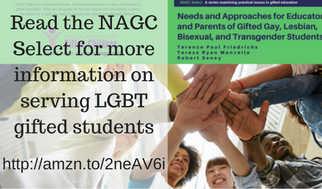NAGC works to support those who enhance the growth and development of gifted and talented children through education, advocacy, community building, and research
Brown, R. M. (1997). Rita Will: Memoir of a literary rabble-rouser. New York, NY: Bantam.
Cross, T. (2013). Suicide among gifted children and adolescents. Waco, TX: Prufrock Press.
Davidson, J., & Davidson. B. (2004). Genius denied: How to stop wasting our brightest young minds. New York, NY: Simon & Schuster.
Friedrichs, T. P. (2012). Counseling gifted GLBT students along paths to freedom. In T. L. Cross & J. R. Cross (Eds.), Handbook for counselors serving students with gifts and talents (pp. 153–174). Waco, TX: Prufrock Press.
Friedrichs, T., Manzella, T., & Seney, R. (2017). Needs and approaches for educators and parents of gifted gay, lesbian, bisexual, and transgender students. Washington, DC: NAGC.
Gay, Lesbian, Straight Education Network (GLSEN) (2016). GLSEN 2015 National School Climate Survey: Executive summary. Retrieved from https://www.glsen.org/article/2015-national-school-climate-survey
Keener, A. G. (2013). G-squared: Supporting your gifted LGBT student. SENGVine, 105. Retrieved from http://sengifted.org/g-squared-supporting-your-gifted-lgbt-student/
Manzella, T. R. (2012). Twice other: Cultural challenges faced by gifted and GLBTQ adolescents (Unpublished master's thesis). Metropolitan State University, St. Paul, MN.
National Association for Gifted Children. (2015). Supporting gifted students with diverse sexual orientations and gender identities. Retrieved from http://www.nagc.org/sites/default/files/Position%20Statement/GLBTQ%20%28sept%202015%29.pdf
Peterson, J. S., & Rischar, H. (2000). Gifted and gay: A study of the adolescent experience. Gifted Child Quarterly, 44, 149–164.
Sedillo P. J. (2013). A retrospective study of gay gifted, young adult males’ perceptions of giftedness and suicide (Doctoral Dissertation). University of New Mexico, Albuquerque
Treat, A. R. (2008). Beyond analysis by gender: Overexcitability dimensions of sexually diverse populations and implications for gifted education (Doctoral dissertation). Retrieved from Proquest. (UMI No. 3344606).
Treat, A. R. (2016, November). Gifted LGBTQ social-emotional issues. Teaching for High Potential, 6–7.
Whittenburg, B., & Treat, A. R. (2009). Shared characteristics of gifted and sexually diverse youth. In N. L. Hafenstein & J. A. Castellano (Eds.), Perspectives in gifted education: Diverse gifted learners (Vol. 4, pp. 130–165). Denver, CO: University of Denver.
Blumfield, W. J. (2016). Some notable same-sex and all-sex loving and gender non-conforming personalities in history. Retrieved from https://www.academia.edu/29512758/Some_Notable_Same-Sex_and_All-Sex-Loving_and_Gender_Non-Conforming_Personalities_in_History.
Cohn, S. J. (2003). The gay gifted learner: Facing the challenge of homophobia and antihomosexual bias in schools. In J. A. Castellano (Ed.), Special populations in gifted education: Working with diverse gifted learners (pp. 123–149). Boston, MA: Allyn & Bacon.
College Choice. (2017). 50 best colleges for LGBTQ students. Retrieved from http://www.collegechoice.net/rankings/50-best-lgbt-friendly-colleges-and-universities/.
Cross, T. L., Gust-Brey, K., & Ball, P. B. (2002). A psychological autopsy of the suicide of an academically gifted student: Researchers’ and parents’ perspectives.  Gifted Child Quarterly, 46, 247–264.
Gifted Child Quarterly, 46, 247–264.
Friedrichs, T., Manzella, T., & Seney, R. (2017). Needs and approaches for educators and parents of gifted gay, lesbian, bisexual, and transgender students. Washington, DC: NAGC.
Gosfield, M. W. (Ed.). (2008). Expert approaches to support gifted learners: Professional perspectives, best practices, and positive solutions. Minneapolis, MN: Free Spirit Publishing.
Huegel, K. (2011). GLBTQ: The survival guide for queer & questioning teens (2nd ed.). Minneapolis, MN: Free Spirit Publishing.
Kosciw, J. G., Greytak, E. A., Bartkiewicz, M. J., Boesen, M. J., & Palmer, N. A. (2012). The 2011 national school climate survey: The experiences of lesbian, gay, bisexual and transgender youth in our nation's schools. New York, NY: Gay, Lesbian and Straight Education Network.
Manzella, T. R. (2014, October). Home for the holidays: Reducing the stress for your gifted GLBTQ Kid. Parenting for High Potential, 2–3.
Manzella, T. R. (2014, July/August). A parent’s perspective: Gifted and GLBTQ. 2e: Twice Exceptional Newsletter, 1–3.
Pearson, J., Muller, C., & Wilkinson, L. (2007). Adolescent same-sex attraction and academic outcomes: The role of school attachment and engagement. Social Problems, 54, 523–542.
Peterson, J. S., & Ray, K. E. (2007). Bullying among the gifted: The subjective experience. Gifted Child Quarterly, 50, 252–269.
Peterson, J. S. (2009). Gifted at risk: Poetic portraits. Scottsdale, AZ: Great Potential Press.
Piechowski, M. M. (2002). Experiencing in a higher key: Dabrowski’s theory of and for the gifted. Gifted Education Communicator, 33(1), 28–31.
Treat, A.R., & Whittenburg, B. (2006). Gifted gay, lesbian, bisexual, and transgender annotated bibliography: A resource for educators of gifted GLBT students. Journal of Secondary Gifted Education, 17(4), 230–243.
Walker, S. Y. (2002). The survival guide for parents of gifted kids: How to understand, live with, and stick up for your gifted child. Minneapolis, MN: Free Spirit Publishing.